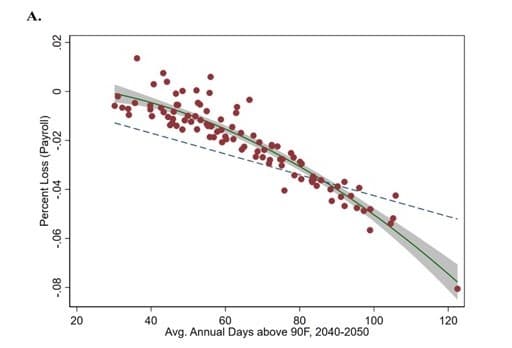Heat has larger impacts on labor in poorer areas
by A. Patrick Behrer, R. Jisung Park, Gernot Wagner, Colleen M. Golja, and David W. Keith

One-sentence summary:
One additional day >32 °C (90 °F) lowers annual payroll by 0.04%, equal to 2.1% of average weekly earnings.
Abstract:
Hotter temperature can reduce labor productivity, work hours, and labor income. The effects of heat are likely to be a joint consequence of both exposure and vulnerability. Here we explore the impacts of heat on labor income in the US, using regional wealth as a proxy for vulnerability. We find that one additional day >32 °C (90 °F) lowers annual payroll by 0.04%, equal to 2.1% of average weekly earnings. Accounting for humidity results in slightly more precise estimates. Proxying for wealth with dividend payments we find smaller impacts of heat in counties with higher average wealth. Temperature projections for 2040–50 suggest that earnings impacts may be 95% smaller for US counties in the richest decile relative to the poorest. Considering the within country distribution of vulnerability, in addition to exposure, to climate change could substantially change estimated within-country differences between the rich and poor in income losses from climate change.
Full paper: "Heat has larger impacts on labor in poorer areas" (15 September 2021; PDF).
Media mentions:
e.g. "More “hottest day ever” mean changing the way we work" by Stephanie Hughes and Addie Costello, NPR Marketplace (5 July 2023); "Heat Is Costing the U.S. Economy Billions in Lost Productivity" by Coral Davenport, New York Times (31 July 2023); "Workers Exposed to Extreme Heat Have Few Protections" by Noah Weiland, New York times (5 October 2023).

